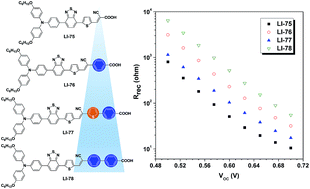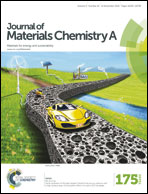The introduction of conjugated isolation groups into the common acceptor cyanoacrylic acid: an efficient strategy to suppress the charge recombination in dye sensitized solar cells and the dramatically improved efficiency from 5.89% to 9.44%†
Abstract
The traditional acceptor, cyanoacrylic acid, was modified by the insertion of different aromatic rings as the isolation groups between the CN and COOH moieties, with the aim to suppress the possible charge recombination in dye sensitized solar cells. The results indicated that the larger isolation group was beneficial to inhibit the interfacial recombination, and the highest Voc was obtained by dye LI-78 with biphenyl as the isolation group. Combined with electron injection, the highest conversion efficiency (η) of 9.44% was achieved by dye LI-76 featuring a phenyl unit as the isolation group, whereas that of the reference sensitizer LI-75 without isolation group was only 5.89% under the same test conditions, providing a simple and convenient method to optimize the photovoltaic performance of organic dyes.


 Please wait while we load your content...
Please wait while we load your content...